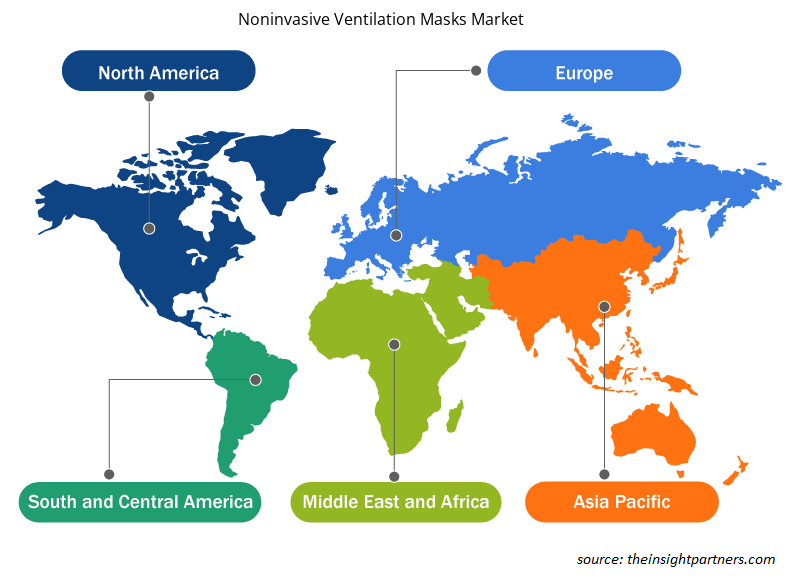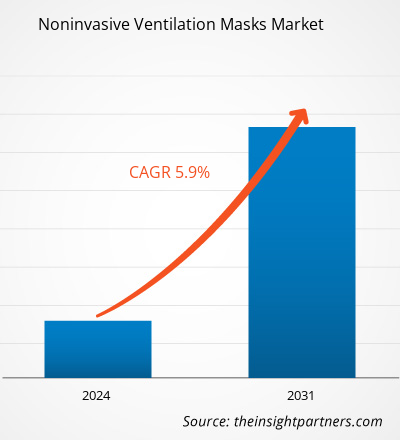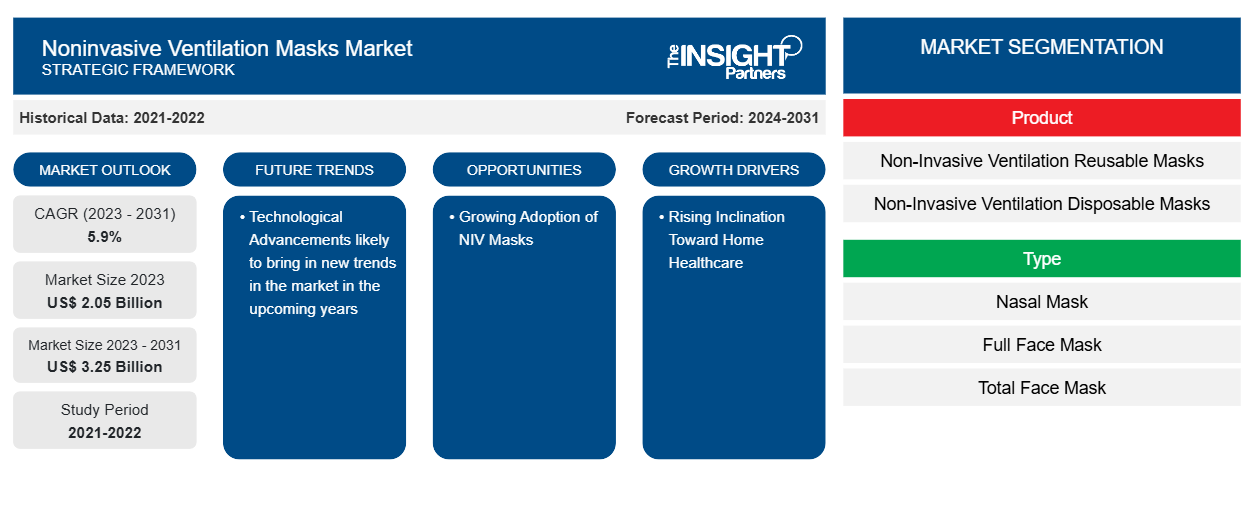Si prevede che il mercato delle maschere per la ventilazione non invasiva raggiungerà i 3,25 miliardi di dollari entro il 2031, rispetto ai 2,05 miliardi di dollari del 2023. Si prevede che il mercato registrerà un CAGR del 5,9% nel periodo 2023-2031. È probabile che i crescenti progressi tecnologici nelle maschere per la ventilazione non invasiva agiranno come una tendenza futura nel mercato nei prossimi anni.
Analisi di mercato delle maschere per ventilazione non invasive
I metodi di ventilazione invasiva vengono spesso evitati nei pazienti con BPCO per ridurre i rischi di complicazioni come infezioni e lesioni polmonari meccaniche. Le maschere di ventilazione non invasive sono preferite perché forniscono supporto respiratorio senza richiedere l'intubazione. Pertanto, la natura cronica e a lungo termine della BPCO e dell'apnea notturna porta ad acquisti ripetuti e crea una domanda di maschere NIV, generando così un mercato stabile e sostenibile per i produttori.
Panoramica del mercato delle maschere per ventilazione non invasive
Secondo le stime del National Council on Aging, Inc., 39 milioni di adulti negli Stati Uniti soffrivano di OSA nel 2023. Secondo un articolo intitolato "Cosa sa una fragile popolazione svizzera sulla broncopneumopatia cronica ostruttiva?", circa 400.000 persone in Svizzera hanno sofferto di BPCO nel 2021. La ventilazione non invasiva (NIV) è la somministrazione di supporto di ossigeno attraverso una maschera facciale, eliminando la necessità di una via aerea endotracheale nel trattamento di varie condizioni, tra cui BPCO, edema polmonare cardiogeno e altre condizioni respiratorie senza complicazioni come debolezza dei muscoli respiratori, trauma delle vie aeree superiori e polmonite associata al ventilatore. Le maschere di ventilazione non invasiva possono essere riutilizzabili o monouso. Le maschere di ventilazione non invasiva monouso sono monouso e vengono smaltite per ridurre il rischio di contaminazione incrociata. I progressi nella progettazione delle maschere, nel comfort, nella durata e nell'incorporazione di materiali delicati sulla pelle possono aumentare l'adozione delle maschere NIV poiché i pazienti cercano prodotti più efficienti e confortevoli. Pertanto, si prevede che l'adozione delle maschere NIV come trattamento efficace di tali diffuse patologie respiratorie continuerà a stimolare la crescita del mercato delle maschere per la ventilazione non invasiva nel periodo 2023-2031.
Personalizza questo report in base alle tue esigenze
Riceverai la personalizzazione gratuita di qualsiasi report, comprese parti di questo report, o analisi a livello nazionale, pacchetto dati Excel, oltre a usufruire di grandi offerte e sconti per start-up e università
-
Scopri le principali tendenze di mercato in questo rapporto.Questo campione GRATUITO includerà analisi di dati che spaziano dalle tendenze di mercato alle stime e alle previsioni.
Driver di mercato e opportunità per le maschere di ventilazione non invasive
Inclinazione crescente verso il mercato dei carburanti per l'assistenza sanitaria domiciliare
Un passaggio da strutture a lungo termine, riabilitazione ospedaliera e strutture infermieristiche specializzate a contesti di assistenza domiciliare si traduce in un'interazione migliore, coerente e tempestiva tra paziente e medico grazie al cloud e ai dispositivi medici basati sulla mobilità . L'epidemia di COVID-19 ha innescato l'importanza dell'assistenza sanitaria domiciliare a causa della limitata capacità di posti letto ospedalieri e della scarsità di professionisti sanitari qualificati. Con l'aiuto dell'assistenza sanitaria domiciliare, i professionisti sanitari possono monitorare i parametri vitali del paziente da remoto ed evitare ricoveri ospedalieri.
Inoltre, i pazienti con patologie quali BPCO, apnea notturna e altri problemi respiratori stanno esprimendo sempre più una preferenza per la gestione domiciliare dei loro disturbi. I pazienti possono utilizzare la terapia NIV nel comfort delle loro case senza dover fare frequenti visite in ospedale. Gli operatori sanitari domiciliari prescrivono maschere NIV più frequentemente come componente di piani di assistenza respiratoria onnicomprensivi.
Pertanto, grazie alla crescente inclinazione verso l'assistenza sanitaria domiciliare e alla crescente domanda di dispositivi più avanzati, convenienti e facilmente utilizzabili a casa, il mercato delle maschere per la ventilazione non invasiva sta guadagnando notevole popolarità.
La crescente adozione delle maschere NIV offre opportunità di mercato
Le maschere di ventilazione non invasive stanno diventando sempre più popolari e stanno ampliando le opportunità di mercato stimolando l'innovazione. La diagnosi e il trattamento precoci sono resi possibili da crescenti campagne di sensibilizzazione sui disturbi respiratori come la BPCO, l'apnea notturna e altri. L'aumento della prescrizione e dell'uso di maschere NIV per la gestione delle malattie deriva da una maggiore consapevolezza tra pazienti e operatori sanitari. Pertanto, è probabile che la crescente consapevolezza della diagnosi precoce stimoli l'adozione di maschere NIV e crei significative opportunità sul mercato. Inoltre, le malattie respiratorie stanno diventando più comuni nelle economie emergenti, in particolare in Asia Pacifico, America Latina e Medio Oriente, a causa dell'inquinamento, dell'urbanizzazione e dei cambiamenti nello stile di vita. Le terapie non invasive stanno diventando ampiamente note in queste aree, per cui è probabile che l'uso di maschere NIV continui a crescere durante il periodo di previsione.
Analisi della segmentazione del rapporto di mercato sulle maschere per ventilazione non invasive
I segmenti chiave che hanno contribuito alla derivazione dell'analisi di mercato delle maschere per la ventilazione non invasive sono il prodotto, l'applicazione e l'utente finale.
- In base al prodotto, il mercato delle maschere per ventilazione non invasiva è diviso in maschere monouso per ventilazione non invasiva e maschere riutilizzabili per ventilazione non invasiva. Il segmento delle maschere monouso per ventilazione non invasiva ha detenuto una quota maggiore del mercato delle maschere per ventilazione non invasiva nel 2023.
- In base all'applicazione, il mercato è segmentato in apnea notturna ostruttiva, broncopneumopatia cronica ostruttiva, polmonite e altri. Il segmento dell'apnea notturna ha detenuto la quota maggiore del mercato delle maschere per la ventilazione non invasiva nel 2023.
- In base all'utente finale, il mercato è segmentato in ospedali e cliniche, assistenza domiciliare e altri. Il segmento ospedali e cliniche ha detenuto la quota maggiore del mercato delle maschere per ventilazione non invasive nel 2023.
Analisi della quota di mercato delle maschere per ventilazione non invasive per area geografica
L'ambito geografico del rapporto di mercato sulle maschere per la ventilazione non invasiva è suddiviso principalmente in cinque regioni: Nord America, Asia Pacifico, Europa, Sud e Centro America e Medio Oriente e Africa. Il Nord America ha dominato il mercato nel 2023. Gli Stati Uniti sono il mercato più grande e in più rapida crescita per le maschere per la ventilazione non invasiva. Secondo l'American Medical Association, circa 30 milioni di persone negli Stati Uniti soffrivano di apnea notturna nel 2022; tuttavia, solo 6 milioni sono stati sottoposti a screening per questa condizione. Inoltre, nello stesso anno a circa 14,8 milioni di adulti è stata diagnosticata la BPCO, che è la quarta causa di morte negli Stati Uniti. Si prevede che la crescente prevalenza di queste malattie polmonari croniche aumenterà la domanda di opzioni di trattamento NIV, stimolando la crescita del mercato delle maschere per la ventilazione non invasiva negli Stati Uniti.
Inoltre, si prevede che la presenza di attori leader del mercato, come Sleepnet Corporation, Philips e Hamilton Medical, che offrono maschere NIV e gli sviluppi strategici di questi attori del mercato negli Stati Uniti aumenteranno la quota di mercato delle maschere per ventilazione non invasiva nel paese durante il periodo di previsione. Ad esempio, nell'agosto 2024, Sleepnet Corporation ha stretto una partnership con un rinomato ospedale pediatrico statunitense per introdurre la maschera Mini Me 2 NIV per studiare l'impatto di dispositivi medici innovativi sull'assistenza ai pazienti.
Approfondimenti regionali sul mercato delle maschere per ventilazione non invasive
Le tendenze regionali e i fattori che influenzano il mercato delle maschere per ventilazione non invasive durante il periodo di previsione sono stati ampiamente spiegati dagli analisti di Insight Partners. Questa sezione discute anche i segmenti e la geografia del mercato delle maschere per ventilazione non invasive in Nord America, Europa, Asia Pacifico, Medio Oriente e Africa e America meridionale e centrale.

- Ottieni i dati specifici regionali per il mercato delle maschere di ventilazione non invasive
Ambito del rapporto di mercato sulle maschere per ventilazione non invasive
| Attributo del report | Dettagli |
|---|---|
| Dimensioni del mercato nel 2023 | 2,05 miliardi di dollari USA |
| Dimensioni del mercato entro il 2031 | 3,25 miliardi di dollari USA |
| CAGR globale (2023-2031) | 5,9% |
| Dati storici | 2021-2022 |
| Periodo di previsione | 2024-2031 |
| Segmenti coperti |
Per Prodotto
|
| Regioni e Paesi coperti |
America del Nord
|
| Leader di mercato e profili aziendali chiave |
|
Maschere per ventilazione non invasive: densità degli attori del mercato: comprendere il suo impatto sulle dinamiche aziendali
Il mercato delle maschere per ventilazione non invasive sta crescendo rapidamente, spinto dalla crescente domanda degli utenti finali dovuta a fattori quali l'evoluzione delle preferenze dei consumatori, i progressi tecnologici e una maggiore consapevolezza dei benefici del prodotto. Con l'aumento della domanda, le aziende stanno ampliando le loro offerte, innovando per soddisfare le esigenze dei consumatori e capitalizzando sulle tendenze emergenti, il che alimenta ulteriormente la crescita del mercato.
La densità degli operatori di mercato si riferisce alla distribuzione di aziende o società che operano in un particolare mercato o settore. Indica quanti concorrenti (operatori di mercato) sono presenti in un dato spazio di mercato in relazione alle sue dimensioni o al valore di mercato totale.
Le principali aziende che operano nel mercato delle maschere per la ventilazione non invasiva sono:
- Azienda medica Hamilton,
- ResMed Inc,
- Fisher & Paykel Healthcare Corp Ltd,
- Sistemi medici Air Liquide,
- Dragerwerk AG & Co KGaA,
Disclaimer : le aziende elencate sopra non sono classificate secondo un ordine particolare.

- Ottieni una panoramica dei principali attori del mercato delle maschere per la ventilazione non invasiva
Notizie di mercato e sviluppi recenti sulle maschere per ventilazione non invasive
Il mercato delle maschere per la ventilazione non invasiva viene valutato raccogliendo dati qualitativi e quantitativi dopo la ricerca primaria e secondaria, che include importanti pubblicazioni aziendali, dati di associazioni e database. Di seguito sono elencati alcuni degli sviluppi del mercato:
- SunMed ha acquisito l'attività di materiali di consumo per anestesia e respiratoria di Vyaire Medical. Questa acquisizione ha unito i punti di forza di entrambe le aziende per migliorare l'innovazione, garantire una fornitura affidabile di prodotti e fornire prodotti medici di alta qualità per risultati migliori per i pazienti. [Fonte: SunMed Group Holdings LLC (AirLife), sito Web aziendale, marzo 2023].
- Intersurgical ha acquisito Pulmodyne, un produttore con sede negli Stati Uniti e in Malesia specializzato in prodotti per le vie aeree e respiratorie. L'acquisizione amplierà la gamma di prodotti Intersurgical, rafforzerà la sua presenza nel mercato statunitense e aumenterà le vendite dei prodotti Pulmodyne a livello globale. (Fonte: ICU Medical, sito Web aziendale, gennaio 2022)
Copertura e risultati del rapporto di mercato sulle maschere per ventilazione non invasive
Il rapporto "Dimensioni e previsioni del mercato delle maschere per ventilazione non invasive (2021-2031)" fornisce un'analisi dettagliata del mercato che copre le seguenti aree:
- Dimensioni e previsioni del mercato delle maschere per la ventilazione non invasive a livello globale, regionale e nazionale per tutti i principali segmenti di mercato coperti dall'ambito
- Tendenze del mercato delle maschere di ventilazione non invasive, nonché dinamiche di mercato come driver, restrizioni e opportunità chiave
- Analisi PEST e SWOT dettagliate
- Analisi di mercato delle maschere di ventilazione non invasive che copre le principali tendenze di mercato, il quadro globale e regionale, i principali attori, le normative e i recenti sviluppi del mercato
- Analisi del panorama industriale e della concorrenza che copre la concentrazione del mercato, l'analisi della mappa di calore, i principali attori e gli sviluppi recenti per il mercato delle maschere di ventilazione non invasive
- Profili aziendali dettagliati
- Analisi storica (2 anni), anno base, previsione (7 anni) con CAGR
- Analisi PEST e SWOT
- Valore/volume delle dimensioni del mercato - Globale, Regionale, Nazionale
- Industria e panorama competitivo
- Set di dati Excel
Report recenti
Testimonianze
Motivo dell'acquisto
- Processo decisionale informato
- Comprensione delle dinamiche di mercato
- Analisi competitiva
- Analisi dei clienti
- Previsioni di mercato
- Mitigazione del rischio
- Pianificazione strategica
- Giustificazione degli investimenti
- Identificazione dei mercati emergenti
- Miglioramento delle strategie di marketing
- Aumento dell'efficienza operativa
- Allineamento alle tendenze normative























 Ottieni un campione gratuito per - Mercato delle maschere per la ventilazione non invasiva
Ottieni un campione gratuito per - Mercato delle maschere per la ventilazione non invasiva